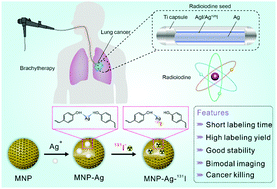Theranostic radioiodine-labelled melanin nanoparticles inspired by clinical brachytherapy seeds†
Abstract
Radioiodine is widely used in nuclear medicine, mainly serving as a tracer and therapeutic agent, and benefits from its various radioactive isotopes of iodine including I-123, I-124, I-125, I-131 and so on. Melanin is a natural material widely dispersed in the human skin, hair and eyes. The excellent biocompatibility and multifunctional abilities of melanin make it a perfect carrier for biomedical applications. Here, we fabricated theranostic radioiodine-labelled melanin nanoparticles (MNPs) through a novel Ag–I two-step method. The Ag–I labelling method for MNP radioiodine-labelling has advantages including a faster labelling time, higher labelling yield, and higher stability than the chloramine-T oxidation method reported previously. The obtained MNP–Ag–131I can be used for both single-photon emission computed tomography and Cherenkov radiation imaging. The β-rays of 131I also make it a good candidate as a cancer cell killer. The theranostic properties of this nanoparticle were also proved in a xenograft tumor model in vivo. In summary, this study provides a new concept for radioiodine labelling nanoparticles, which can be further investigated in various imaging and radiotherapy applications with different radioactive isotopes of iodine.



 Please wait while we load your content...
Please wait while we load your content...